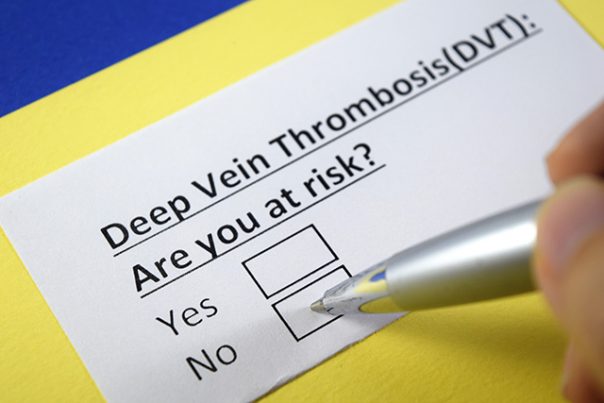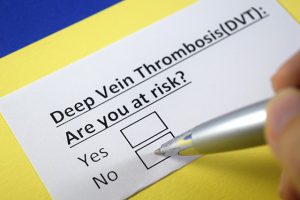
Deep vein thrombosis – causes, side effects and treatments at NaturalPedia.com
Wednesday, February 28, 2018 by Janine Acero
http://www.naturalpedia.com/deep-vein-thrombosis-causes-side-effects-and-treatments-at-naturalpedia-com.html

Deep vein thrombosis (DVT) is a blood clot that forms in a vein – typically in the lower leg or thigh, but it can also occur in the arms. This blood clot becomes dangerous if a piece of the blood clot breaks off or travels through the bloodstream, through the heart and the pulmonary arteries. This piece of the blood clot blocks a major blood vessel in the lung, causing the condition known as pulmonary embolism. Some people aren’t aware of having DVT until they show symptoms of pulmonary embolisms, such as shortness of breath, pain with breathing, and coughing up blood.

Known symptoms and risk factors of deep vein thrombosis
Some risk factors for developing these dangerous blood clots include:
- Immobility (e.g., prolonged bed rest due to illness or injury; long travel by car or airplane)
- Pregnancy
- Contraceptives or hormone therapy
- Smoking
- Cancer
- Injury or surgery that damages the veins in the arm or leg or adjacent tissues
- Family history or genetic predisposition to forming blood clots
- Obesity
Not all patients with DVT show any symptoms at all, and these are sometimes mistaken for other conditions. Other common signs of a blood clot in the leg are pain, swelling, muscle tenderness, warmth and redness of the arm or leg.
Body systems harmed by deep vein thrombosis
DVT affects the lungs and the respiratory system in general.
Food items or nutrients that may prevent deep vein thrombosis
DVT is a serious health condition, but certain home remedies can be used to reduce its symptoms. The following are some foods that can help prevent DVT. Consult with a healthcare provider about how to best utilize these food items for best results.
- Cayenne pepper – The compound capsaicin found in cayenne promotes smooth blood circulation, which makes it an effective natural blood thinner that helps in treating DVT. It also strengthens the arteries and capillaries, and helps normalize blood pressure, and reduces cholesterol and triglyceride levels.
- Cinnamon – Cinnamon contains a natural anticoagulant called coumarin that lowers blood pressure and acts as a blood thinner.
- Garlic – Garlic is known to promote blood circulation and helps get rid of all the effects of DVT.
- Ginger – Ginger can break down the fibrins that cause DVT and can help prevent high cholesterol that causes plaque buildup, which inhibits blood circulation. It also boosts blood circulation in the arteries and veins.
- Turmeric – Curcumin, the active ingredient in turmeric, helps prevent the formation of blood clots, as well as reduce the risk of plaque buildup in the arteries. Its anti-inflammatory activity helps reduce pain and swelling.
- Vitamin E rich foods – Vitamin E acts as an anticoagulant (blood thinner) for the veins. Walnuts, almonds, hazelnuts, olive oil, broccoli, avocado, spinach, sunflower seeds, bell peppers and kiwis help the blood to flow smoothly.
Treatments, management plans for deep vein thrombosis
Treatment typically involves taking anticoagulants, as well as medicines to ease pain and inflammation. Keeping the affected area raised and applying heat can also help. If you are taking a long car or plane trip, take a break, walk or stretch your legs and drink plenty of liquids.
Regular exercise helps lower your risk of blood clots and DVT and promotes overall health. Moderate daily exercise helps improve blood circulation and helps fight obesity, one of the risk factors of DVT.
You don’t have to choose a rigorous weight training. You can try to focus on walking and mild aerobic exercises:
- Walk for 30 minutes or more, at least five times a week. Also, get up and walk around every two to three hours for 10 minutes.
- Enjoy swimming, jogging, biking, and similar activities a few times a week.
- Do simple foot and leg exercises for 15 minutes daily in the morning.
- While sitting for a long period, exercise your legs frequently.
Consult a healthcare provider for an exercise plan that is suitable for your condition.
Where to learn more
- Avoiding Deep Vein Thrombosis During Air Travel
- Long Duration Flights Triple Risk of Blood Clots (DVT)
- What causes blood clots and what are some symptoms?
- Fertility Awareness-Based Methods: Birth Control without the Drugs
Summary
Deep vein thrombosis (DVT) is a blood clot that forms in a vein in the limbs or extremities. This blood clot blocks a major blood vessel in the lung, causing the condition known as pulmonary embolism.
One of the main risk factors for DVT is prolonged immobility such as bed rest and long travels by car or airplane.
Sources include:
Tagged Under: Tags: deep vein thrombosis





